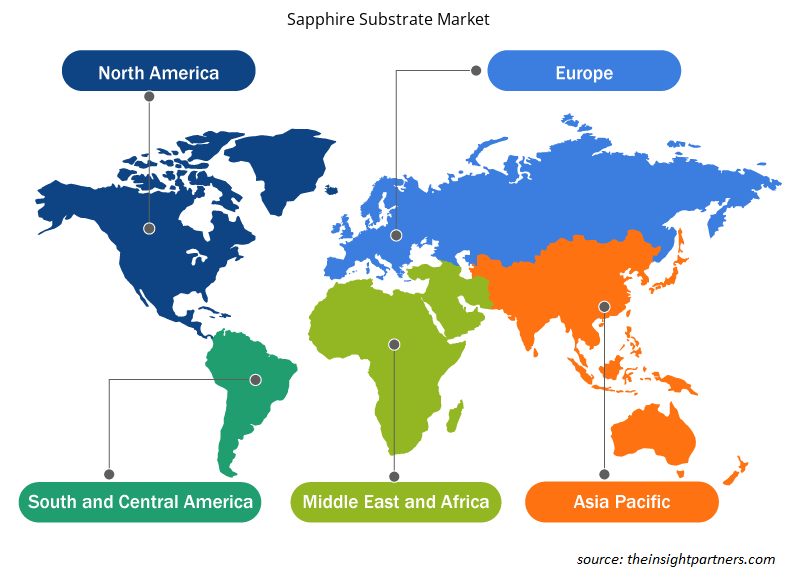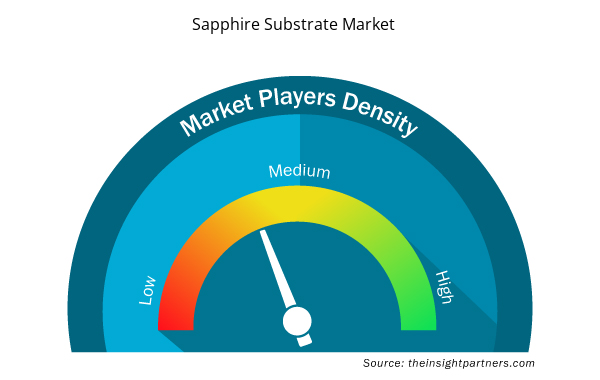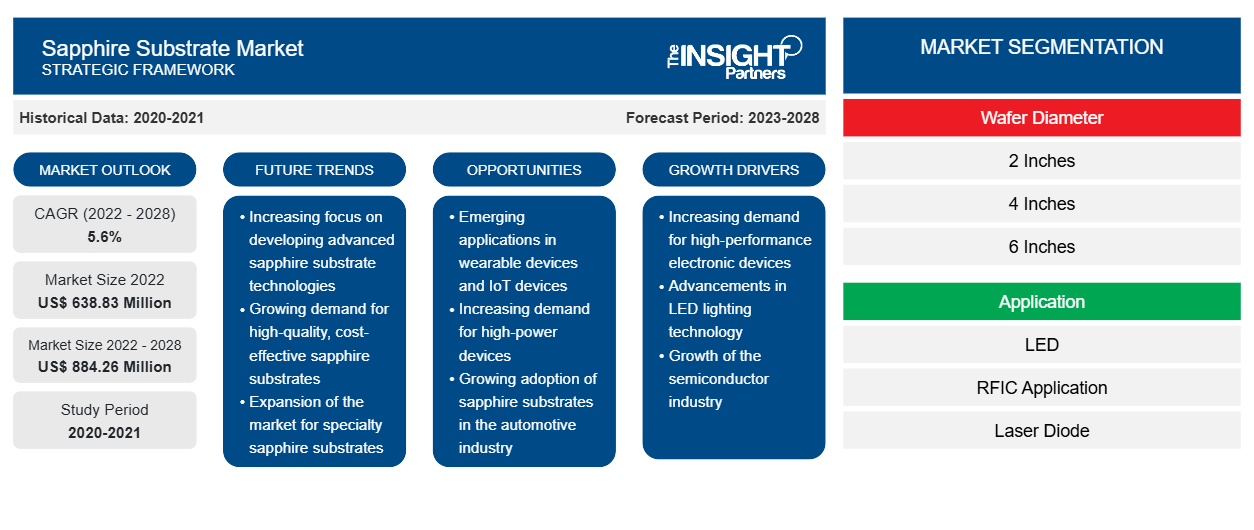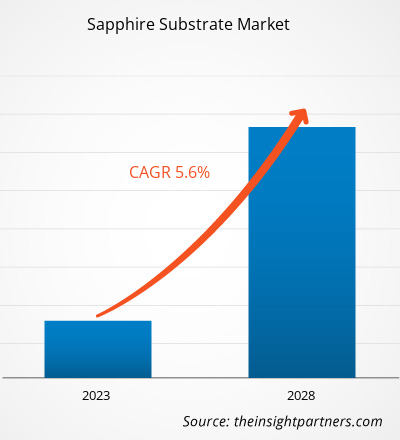蓝宝石衬底市场规模预计将从 2022 年的 6.3883 亿美元增至 2028 年的 8.8426 亿美元;预计 2022 年至 2028 年的复合年增长率为 5.6%。
消费电子产品为蓝宝石基板市场带来了巨大的增长机会。智能手机和其他电子产品的制造商对使用蓝宝石基板很感兴趣。随着全球消费电子产品需求的不断增长,制造商正专注于生产可用于消费电子产品的蓝宝石基板。蓝宝石基板市场参与者还专注于开发用于 LED 的无色蓝宝石晶片,因为有色蓝宝石晶片有负面影响。例如,2022 年 4 月,沙特阿拉伯的研究人员通过在晶片级上绝缘基板开发了单晶石墨烯。研究人员认为这一发展很重要,因为由蓝宝石生长的单晶石墨烯单层产生的晶体管的场效应非常出色。
近年来,LED制造商为了控制成本和提高产品质量,对高品质无色蓝宝石的需求不断增加。因此,采用无色蓝宝石基板预计将在预测期内为蓝宝石基板市场增长带来新的机会。此外,由于各国大晶体开采活动的增加,蓝宝石的生产水平也将提高。蓝宝石将与现有的半导体制造工艺相结合,从而降低蓝宝石基板的整体成本。
定制此报告以满足您的需求
您可以免费定制任何报告,包括本报告的部分内容、国家级分析、Excel 数据包,以及为初创企业和大学提供优惠和折扣
- 获取此报告的关键市场趋势。这个免费样品将包括数据分析,从市场趋势到估计和预测。
COVID-19 疫情对蓝宝石基板市场规模的影响
COVID-19 疫情对欧洲产生了显著的负面影响,表明在欧洲经济从疫情中复苏的同时,该地区的半导体和电子预算可能会受到相当大的打击。由于 COVID-19 疫情严重影响了整体预算,许多欧洲国家削减了电子和半导体支出。对采购计划和研发 (R&D) 活动的积极影响预计将在未来几年对欧洲的蓝宝石衬底市场产生重大影响。由于需求模式的变化、企业倒闭、失业以及许多国家的国内生产总值 (GDP) 前所未有的下降,预计欧盟的消费电子行业的需求将出现最大幅度的下降,并且随着时间的推移,性能差距将扩大。由于各国政府将在未来几年向购车者提供激励措施,预计区域汽车和运输行业将会增长。sizeable hit while Europe’s economies recover from the outbreak. Since the COVID-19 outbreak severely impacted overall budgets, many European countries reduced their electronics and semiconductor expenditure. The positive impact on the procurement programs and research & development (R&D) activities is anticipated to significantly affect the sapphire substrate market in Europe in the coming years. The
各国政府和主要市场参与者的重大举措正使欧盟蓝宝石衬底市场从 COVID-19 大流行的不利影响中恢复过来。欧盟正寻求在 2030 年前跻身全球半导体制造业顶级联盟。英特尔的目标是建造一座价值 200 亿美元的半导体工厂。欧洲在半导体行业供应链中已经站稳了脚跟。然而,在制造最高端晶圆方面,欧洲远远落后于亚洲。因此,英国、德国和法国政府正在对半导体技术进行大量投资,并专注于建立伙伴关系和合作以促进区域市场的发展。欧盟和欧洲自由贸易联盟 (EFTA) 的主要生产中心的建立,包括奥地利、法国、德国、意大利、爱尔兰和荷兰,所有这些国家都是多家领先制造商的所在地,预计将推动欧洲蓝宝石衬底市场的增长。EU’s sapphire substrate market to recover from the adverse effects of the COVID-19 pandemic. The EU is seeking to launch itself into the global premier league of semiconductor manufacturing by 2030. Intel aims to build a US$ 20 billion semiconductor factory. Europe has established itself significantly in the semiconductor industry supply chain. However, it lags far behind Asia in the manufacturing of highest-end wafers. Thus, the governments of the UK, Germany, and France are making significant investments in the semiconductor technology and focusing on partnerships and collaborations to boost the regional market. The establishments of key production centers in the EU and European Free Trade Association (EFTA) that include Austria, France, Germany, Italy, Ireland, and the Netherlands, all of these countries are home to several leading manufacturers is projected to boost the Europe’s sapphire substrate market growth.
市场洞察 – 蓝宝石基板市场
蓝宝石衬底市场以亚太地区为主,其次是北美、欧洲、中东和非洲以及南美和中美洲。“四大”半导体地区——韩国、日本、中国和台湾——在半导体行业的上游、中游和下游增长中发挥了关键作用,甚至在全球范围内也是如此。为了在如此激烈的竞争环境中竞争和繁荣,随着半导体需求的增长和多样性标准的提高,亚太国家将加快半导体业务的研发和创新速度。因此,亚太地区将成为全球半导体行业的支柱。例如,2020 年 8 月,合成蓝宝石生长和加工的主要参与者 Monocrystal 启动了一个项目,旨在为颠覆性的发光二极管( LED) 应用制造超大直径蓝宝石晶片。俄罗斯中国政府间委员会已批准了该项目的投资合作。这些因素将促进该地区的巨大增长,并使亚太地区在预测期内成为蓝宝石衬底市场规模的主要地区。APAC, followed by North America, Europe, Middle East & Africa, and South & Central America. The "Big Four" semiconductor areas—South Korea, Japan, China, and Taiwan—have played a key role in the semiconductor industry's upstream, midstream, and downstream growth, even globally. To compete and flourish in such a highly competitive environment, Asia Pacific nations will accelerate the speed of R&D and innovation in the semiconductor business as demand for semiconductors grows and diversity standards rise. As a result, Asia Pacific will become the global semiconductor industry's backbone. For instance, in August 2020, Monocrystal—a key player in synthetic sapphire growing and processing—started a project aiming to manufacture extra-large diameter sapphire wafers for disruptive
基于应用的洞察
蓝宝石衬底市场按应用细分为 LED、RFIC 应用、激光二极管、蓝宝石上硅 (SOS) IC 和其他。蓝宝石衬底用于生产晶圆上硅,以生产高性能射频集成电路 (RFIC) 应用。蓝宝石衬底在 LED 中的使用率很高,因为它具有良好的电绝缘性和耐高温性。2021 年,LED 部门在蓝宝石衬底市场份额中处于领先地位。RFIC Application, Laser Diode, and Silicon on Sapphire (SOS) IC, and Others. Sapphire substrates are used in the production of silicon-on-wafers to produce high performance radio frequency integrated circuit (RFIC) application. The use of sapphire substrates is high in LED as it has good electrical insulation and high temperature resistance. The LED segment led the sapphire substrate market share in 2021.
蓝宝石衬底市场根据晶圆直径、应用和地理位置进行细分。根据晶圆直径,市场细分为 2 英寸、4 英寸、6 英寸和其他。根据应用,市场细分为 LED、RFIC、激光二极管和蓝宝石硅基 (SOS) IC 和其他。根据地理位置,蓝宝石衬底市场主要细分为北美、欧洲、亚太地区 (APAC)、中东和非洲 (MEA) 以及南美和中美。RFIC, laser diode, and silicon on sapphire (SOS) IC and others. Based on geography, the sapphire substrate market is primarily segmented into North America, Europe, Asia Pacific (APAC), the Middle East & Africa (MEA), and South and Central America.
蓝宝石衬底市场区域洞察
Insight Partners 的分析师已详尽解释了预测期内影响蓝宝石衬底市场的区域趋势和因素。本节还讨论了北美、欧洲、亚太地区、中东和非洲以及南美和中美洲的蓝宝石衬底市场细分和地理位置。

- 获取蓝宝石衬底市场的区域具体数据
蓝宝石衬底市场报告范围
| 报告属性 | 细节 |
|---|---|
| 2022 年市场规模 | 6.3883亿美元 |
| 2028 年市场规模 | 8.8426亿美元 |
| 全球复合年增长率(2022 - 2028) | 5.6% |
| 史料 | 2020-2021 |
| 预测期 | 2023-2028 |
| 涵盖的领域 | 按晶圆直径
|
| 覆盖地区和国家 | 北美
|
| 市场领导者和主要公司简介 |
|
蓝宝石基板市场参与者密度:了解其对业务动态的影响
蓝宝石基板市场正在快速增长,这得益于终端用户需求的不断增长,而这些需求又源于消费者偏好的不断变化、技术进步以及对产品优势的认识不断提高等因素。随着需求的增加,企业正在扩大其产品范围,进行创新以满足消费者的需求,并利用新兴趋势,从而进一步推动市场增长。
市场参与者密度是指在特定市场或行业内运营的企业或公司的分布情况。它表明在给定市场空间中,相对于其规模或总市场价值,有多少竞争对手(市场参与者)存在。
在蓝宝石基板市场运营的主要公司有:
- 日进显示器有限公司
- 京瓷公司
- 梅勒光学有限公司
- 单晶体
- Rubicon 技术公司
免责声明:上面列出的公司没有按照任何特定顺序排列。

- 了解蓝宝石衬底市场主要参与者概况
圣戈班集团、京瓷株式会社、Semiconductor Wafer, Inc.、Precision Micro-Optics, Inc. 和 Crystalwise Technology, Inc. 是蓝宝石基板市场的主要参与者。
从事蓝宝石衬底市场研究的参与者主要集中于先进、高效产品的开发。
- 2022 年,Meller Optics, Inc. 推出了全系列小型高精度蓝宝石和红宝石球,用于仪器、计量设备和其他需要低摩擦轴承、长寿命和尺寸精度的精密机械。
- 2021 年,Meller Optics, Inc. 发布了定制蓝宝石窗户和圆顶,适用于屏蔽在恶劣环境下使用的军用和商用无人机上的摄像头、探测器和传感器。
- 历史分析(2 年)、基准年、预测(7 年)及复合年增长率
- PEST 和 SWOT 分析
- 市场规模价值/数量 - 全球、区域、国家
- 行业和竞争格局
- Excel 数据集


- Fertilizer Additives Market
- Occupational Health Market
- Ceramic Injection Molding Market
- Educational Furniture Market
- Sweet Potato Market
- Nuclear Decommissioning Services Market
- Point of Care Diagnostics Market
- Playout Solutions Market
- Pharmacovigilance and Drug Safety Software Market
- Wind Turbine Composites Market

Report Coverage
Revenue forecast, Company Analysis, Industry landscape, Growth factors, and Trends

Segment Covered
This text is related
to segments covered.

Regional Scope
North America, Europe, Asia Pacific, Middle East & Africa, South & Central America

Country Scope
This text is related
to country scope.
常见问题
By 2028, the global market size of sapphire substrate market will be USD 884.26 Million.
Mexico, Russia, Germany, India, South Korea, Saudi Arabia are registering a high growth rate during the forecast period.
LED segment held the largest share in sapphire substrate market. The sapphire substrates are mostly used in producing light-emitting diodes (LEDs) due to 3 major reasons: Mechanical strength, flatness, and light transmission.
China holds the major market share of sapphire substrate market in 2022.
Saint-Gobain Group, KYOCERA Corporation, Semiconductor Wafer, Inc., Precision Micro-Optics, Inc., and Crystalwise Technology, Inc. are the five key market players operating in the global sapphire substrate market.
Growing trend of using large LEDs is one of the major trends anticipated to propel the market growth during the forecast period.
Rising uptake of silicon-on-sapphire microelectronic circuits and increasing demand for sapphire substrate in led applications are major driving factors contributing towards the growth of sapphire substrate market.
The global sapphire substrate market was valued USD 638.83 million in 2022.
The List of Companies - Sapphire Substrate Market
- Iljin Display Co. Ltd.
- Kyocera Corporation
- Meller Optics, Inc.
- Monocrystal
- Rubicon Technology Inc.
- Cryscore Optoelectronic Limited
- Precision Micro-Optics Inc.
- Saint Gobain S.A
- Semiconductor Wafer Inc.
- Crystalwise Technology Inc.
The Insight Partners performs research in 4 major stages: Data Collection & Secondary Research, Primary Research, Data Analysis and Data Triangulation & Final Review.
- Data Collection and Secondary Research:
As a market research and consulting firm operating from a decade, we have published and advised several client across the globe. First step for any study will start with an assessment of currently available data and insights from existing reports. Further, historical and current market information is collected from Investor Presentations, Annual Reports, SEC Filings, etc., and other information related to company’s performance and market positioning are gathered from Paid Databases (Factiva, Hoovers, and Reuters) and various other publications available in public domain.
Several associations trade associates, technical forums, institutes, societies and organization are accessed to gain technical as well as market related insights through their publications such as research papers, blogs and press releases related to the studies are referred to get cues about the market. Further, white papers, journals, magazines, and other news articles published in last 3 years are scrutinized and analyzed to understand the current market trends.
- Primary Research:
The primarily interview analysis comprise of data obtained from industry participants interview and answers to survey questions gathered by in-house primary team.
For primary research, interviews are conducted with industry experts/CEOs/Marketing Managers/VPs/Subject Matter Experts from both demand and supply side to get a 360-degree view of the market. The primary team conducts several interviews based on the complexity of the markets to understand the various market trends and dynamics which makes research more credible and precise.
A typical research interview fulfils the following functions:
- Provides first-hand information on the market size, market trends, growth trends, competitive landscape, and outlook
- Validates and strengthens in-house secondary research findings
- Develops the analysis team’s expertise and market understanding
Primary research involves email interactions and telephone interviews for each market, category, segment, and sub-segment across geographies. The participants who typically take part in such a process include, but are not limited to:
- Industry participants: VPs, business development managers, market intelligence managers and national sales managers
- Outside experts: Valuation experts, research analysts and key opinion leaders specializing in the electronics and semiconductor industry.
Below is the breakup of our primary respondents by company, designation, and region:

Once we receive the confirmation from primary research sources or primary respondents, we finalize the base year market estimation and forecast the data as per the macroeconomic and microeconomic factors assessed during data collection.
- Data Analysis:
Once data is validated through both secondary as well as primary respondents, we finalize the market estimations by hypothesis formulation and factor analysis at regional and country level.
- Macro-Economic Factor Analysis:
We analyse macroeconomic indicators such the gross domestic product (GDP), increase in the demand for goods and services across industries, technological advancement, regional economic growth, governmental policies, the influence of COVID-19, PEST analysis, and other aspects. This analysis aids in setting benchmarks for various nations/regions and approximating market splits. Additionally, the general trend of the aforementioned components aid in determining the market's development possibilities.
- Country Level Data:
Various factors that are especially aligned to the country are taken into account to determine the market size for a certain area and country, including the presence of vendors, such as headquarters and offices, the country's GDP, demand patterns, and industry growth. To comprehend the market dynamics for the nation, a number of growth variables, inhibitors, application areas, and current market trends are researched. The aforementioned elements aid in determining the country's overall market's growth potential.
- Company Profile:
The “Table of Contents” is formulated by listing and analyzing more than 25 - 30 companies operating in the market ecosystem across geographies. However, we profile only 10 companies as a standard practice in our syndicate reports. These 10 companies comprise leading, emerging, and regional players. Nonetheless, our analysis is not restricted to the 10 listed companies, we also analyze other companies present in the market to develop a holistic view and understand the prevailing trends. The “Company Profiles” section in the report covers key facts, business description, products & services, financial information, SWOT analysis, and key developments. The financial information presented is extracted from the annual reports and official documents of the publicly listed companies. Upon collecting the information for the sections of respective companies, we verify them via various primary sources and then compile the data in respective company profiles. The company level information helps us in deriving the base number as well as in forecasting the market size.
- Developing Base Number:
Aggregation of sales statistics (2020-2022) and macro-economic factor, and other secondary and primary research insights are utilized to arrive at base number and related market shares for 2022. The data gaps are identified in this step and relevant market data is analyzed, collected from paid primary interviews or databases. On finalizing the base year market size, forecasts are developed on the basis of macro-economic, industry and market growth factors and company level analysis.
- Data Triangulation and Final Review:
The market findings and base year market size calculations are validated from supply as well as demand side. Demand side validations are based on macro-economic factor analysis and benchmarks for respective regions and countries. In case of supply side validations, revenues of major companies are estimated (in case not available) based on industry benchmark, approximate number of employees, product portfolio, and primary interviews revenues are gathered. Further revenue from target product/service segment is assessed to avoid overshooting of market statistics. In case of heavy deviations between supply and demand side values, all thes steps are repeated to achieve synchronization.
We follow an iterative model, wherein we share our research findings with Subject Matter Experts (SME’s) and Key Opinion Leaders (KOLs) until consensus view of the market is not formulated – this model negates any drastic deviation in the opinions of experts. Only validated and universally acceptable research findings are quoted in our reports.
We have important check points that we use to validate our research findings – which we call – data triangulation, where we validate the information, we generate from secondary sources with primary interviews and then we re-validate with our internal data bases and Subject matter experts. This comprehensive model enables us to deliver high quality, reliable data in shortest possible time.


 获取此报告的免费样本
获取此报告的免费样本